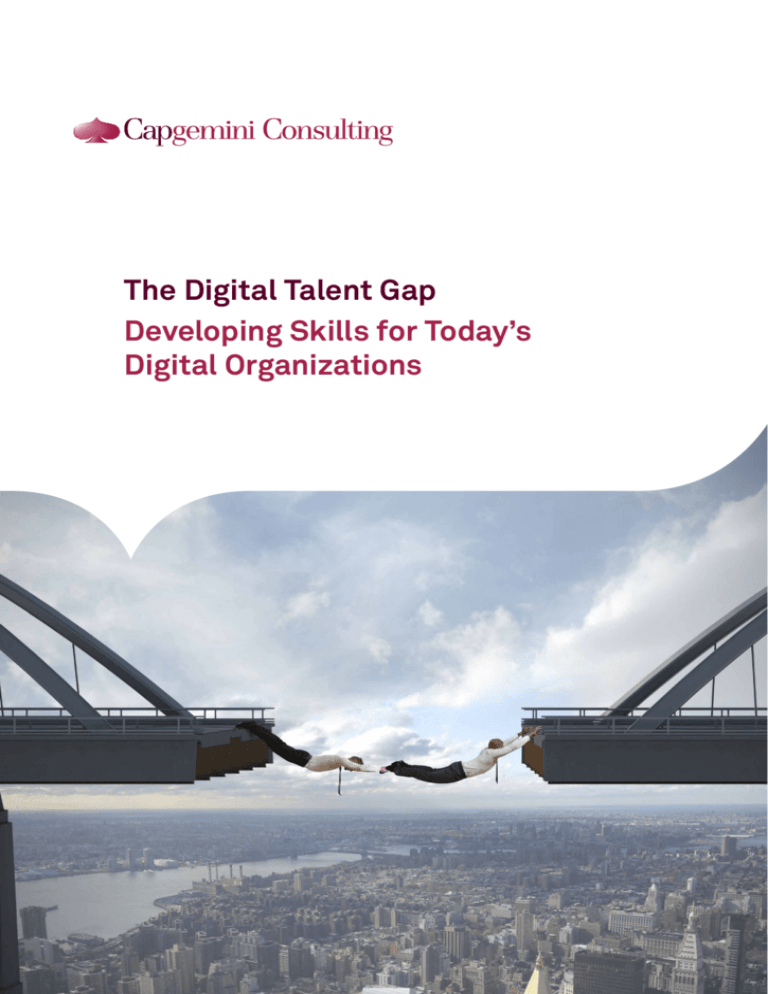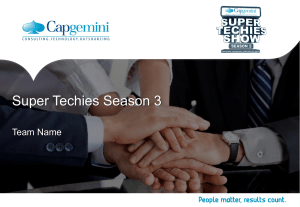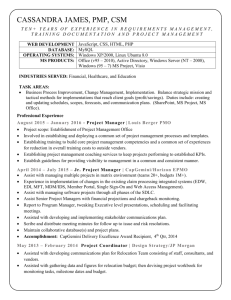
The Digital Talent Gap
Developing Skills for Today’s
Digital Organizations
The War for Talent Has Gone Digital
The shortage of digital skills in the
current marketplace is unprecedented.
It is estimated that over 4.4 million IT
jobs will be created around Big Data by
2015; however, only a third of these new
jobs will be filled1. Martha Lane Fox, the
UK’s digital inclusion champion, believes
over 16 million people in the UK lack the
basic digital skills to fully benefit from the
Internet2. Even Millenials are a matter of
concern. In a survey comprising over 800
middle to upper management executives
from over 50 industries, nearly one in five
Millenials in the modern workplace are
perceived to be lacking in analytical skills3.
The impact of digital
technologies is now
felt not only in the IT
department, but across
the entire organization,
creating a huge demand
for digital skills.
The reasons driving this skills shortage
are not hard to identify. The usage of
mobile, social and analytical tools is
permeating the length and breadth of
every function across the organization.
Unlike the past, the impact of these digital
technologies and tools is felt not just in
the IT department. This means that the
magnitude of training and re-skilling that
is required is enormous. Moreover, each
new technology cycle has brought forth
new requirements and these cycles are
increasingly getting shorter. Employees
must now refresh their skills more
frequently if they wish to stay relevant in
this rapidly changing digital environment.
The head of India R&D Labs of software
firm SAP succinctly states: “The shelf life
of a software engineer today is no more
than that of a cricketer – about 15 years.
The 20-year-old guys provide me more
value than the 35-year-olds do.4”
digital skills as the key hurdle to their
digital transformation5. Digital leaders or
‘Digirati’a are already investing in digital
skills and reaping significant benefits in
comparison to other companies (see
Figure 1). On average, ‘Digirati’ are
26% more profitable than their industry
competitors.
This skills shortage is creating a ‘war for
talent’, where companies have to compete
for the best talent with new categories of
players. Unlike in the past, the hunt for the
best talent is no more limited to localized
skills in certain departments. In this case,
the talent war is manifest across the entire
organization. The important questions
are: Do organizations include digital skills
as a key component in their workforce
plans? Are HR departments equipped
and skilled to bring innovative solutions
to bridge the digital skills gap? How are
Digiratis developing digital skills?
Organizations are beginning to recognize
the magnitude of the problem. Our
own research with the MIT Center
for Digital Business has revealed that
77% of companies considered missing
Figure 1: Digital Leaders or ‘Digirati’ are already investing in digital skills and reaping the benefits
We are investing in the necessary digital skills
We agree/strongly agree we have digital skills
26%
Digirati
All others
11%
82%
25%
23%
7%
9%
40%
82% of respondents from Digirati agreed,
compared to 40% in other firms
Analytics
Social
All Others
Mobile
Digirati
Source: Capgemini Consulting – MIT Center for Digital Business Research, The Digital Advantage: How digital leaders outperform their peers in every industry, 2012
a
2
Organizations that truly transform by leveraging digital technologies
Current Approaches to Developing
Digital Skills are Broken
77% of companies consider
missing digital skills as the
key hurdle to their Digital
Transformation.
Organizations are currently facing an
acute shortage of digital skills. To find
out the current level of skills shortage
and reasons behind this shortage, we
interviewed companies across the globe.
Companies are Not
Investing in Digital Skills
Over 90% of the companies we
interviewed stated that they did not have
necessary skills in the areas of social
media, mobile, internal social networks,
process automation and performance
monitoring and analysis6. That is not to
say they do not realize the importance
of such digital skills. Our research
with the MIT uncovered that 87% of
companies feel digital transformation is a
competitive opportunity7. However, only
46% were investing in the development
of digital skills8.
Despite the skills shortage,
only 46% of companies are
investing in developing
digital skills.
Training Programs are Out
of Sync
A key challenge that we uncovered was
how out of sync the training efforts were.
We found that only 4% of companies
ensured that their training efforts were
aligned with their overall digital strategy.
The result of this lack of synchronization
and alignment became clear when we
analyzed corporate training budgets
allocated to digital. We found that none
of the companies we surveyed spends
more than 20% of its training budget on
digital. Such poor investment is clearly
reflected in the limited reach of training
initiatives. For an overwhelming 95% of
companies, only 20% of their workforce
benefited from trainings on digital8 (see
page 4).
Only 4% of companies we
interviewed are aligning
their training efforts with
their digital strategy.
Many Companies Continue
to Use Traditional
Approaches for Sourcing
Digital Skills
Companies seem to be overly cautious
and conservative in their acquisition
of digital skills. We found that while
companies are increasingly using
multiple methods to source digital
skills, they still rely heavily on traditional
methods such as training, recruitment
and partnership. In our survey, over 63%
of companies are using such traditional
methods to source digital talent10. On
the other hand, only 13% of companies
are using innovative methods such as
targeted company acquisition or an
incubator approach (see page 4). While
traditional methods definitely need to
be considered, other inventive avenues
present many untapped opportunities.
There have been many success
stories of companies that have used
innovative approaches such as acquiring
companies and engaging startups
through incubation.
The Human Resources
Function is Not Actively
Involved in Digital Skills
Development
An added challenge appears to be
the fact that HR is not in the driver’s
seat when it comes to steering digital
skills development. We found that only
30% of organizations have mentioned
HR as being actively involved in skills
development11. So, the question remains
who is managing the transformation of
skills if it is not HR? In over 60% of the
companies we surveyed, it was the senior
leadership, IT division, functional teams
and employees who were spearheading
digital skills development12.
This lack of investment and alignment
with digital strategy is worrisome as
it means that companies still have a
long way to go before they can resolve
their digital skills issue. Apart from the
investment focus, a talent shortage of
the magnitude that organizations face
today requires a more proactive stance
on the part of companies. Organizations
need to tap into newer platforms for
acquiring skills while also accelerating
the pace of skills development. They
need to understand that traditional
skills and approaches are not going to
help them in the digital age. In the next
section, we take a look at the skills that
organizations need in order to thrive in
the digital world.
3
Current Approaches to Developing
Digital Skills are Broken
Companies realize the digital skills gap and its importance
90%
Over
of companies
lack digital skills
87%
of companies feel
digital transformation
is a competitive opportunity
Yet, they are not investing in digital skills
Only
46%
are investing in
developing digital skills
Moreover, existing efforts to develop skills are out of sync
4%
Only
Only
20%
of companies align their
training efforts with
their digital strategy
No company spends
> 20% of its
training budget on digital
of companies’ workforce benefits from training on digital
Companies Continue to Use Traditional
Approaches to Source Digital Skills
Over
63%
Only
of companies are using
traditional methods
to source digital talent
13%
of companies are using
innovative methods
Human Resources Function is Not Actively
Involved in Digital Skills Development
Only
30%
4
Over
of organizations have
mentioned HR as being
actively involved in
skills development
60%
of companies have identified
senior leadership, IT division,
functional teams and
employees as leading cohorts
What Skills are Most Relevant for
the Digital Age?
One of the common challenges that most
organizations have faced in the past
is how technical teams and business
teams speak different languages. In
today’s digital age, this will prove to be
a significant hurdle. The proliferation of
digital tools and technologies across
functions means that the business
worker has to learn sufficient technical
skills. At the same time, the technical
engineer should be ready to speak the
business language in order to be in
sync with their marketing and product
counterparts. In the long-term, the need
is for an evolved professional who is
equally comfortable with business and
technology (see Figure 2).
There is Demand for New
Types of Technical Skills
There is a growing usage of Big Data
analytics, social media platforms and
mobile devices. This, is turn, is forcing
employees to acquire skills in these
areas.
For instance, our survey indicated that
over 50% of companies realize that
mobile is one of the two most important
Over 50% of companies
realize mobile is a
key skill for digital
transformation; over
80% of them face a talent
shortage in mobile.
skills for digital transformation. However,
over 80% of these companies face a
talent shortage in mobile13. Mobile skills
encompass design skills, e.g. platformdesign, user-interface and gamification
as well as technical skills such as app
development, cloud services, mobile
device management and security.
Similarly, in a survey conducted with
American
executives,
over
85%
mentioned that they have a Big Data
initiative planned or in progress; however,
only 21% rated their company’s analytics
capabilities as “more than adequate” or
“world class”. Moreover, all respondents
cited facing issues while hiring analytical
talent with more than 75% saying that it
is challenging to source such skills14.
Like mobile and analytics, social media
skills is another skill area that is in demand.
In a survey conducted with respondents
from organizations with over 50,000
employees, only 13% of companies
described their social media efforts as
advanced15. These social media skills
encompass soft skills such as building
a brand, community participation, virtual
facilitation, online etiquette and front-end
engagement skills such as social media
outreach, community management,
customer service and public relations.
Our Digital Maturity Assessment survey
also highlighted that over 50% of
companies lacked social media skills.
Only 13% of companies
described their social
media efforts as
advanced.
Figure 2: Skill Evolution for the Digital Age
Mobile
Analytics
Technical
Talent
Business
Professionals
Strong understanding
of Business Drivers
Knowledge of
technical
underpinnings
Digital Age
Employee
Social
Source: Capgemini Consulting Analysis
5
Technical Talents Need a
Strong Understanding of
Business The lack of advanced technical skills
in mobile, analytics and social media
isn’t the only challenge that companies
face. They also need to increasingly
complement these digital skills with
business acumen. The true potential of
digital skills is realized when they are
combined with a robust understanding
of the business. For instance, the real
value of data analytics stems from an
organization’s ability to operationalize
these insights. This requires combining
data prowess with strategic and
creative thinking, collaboration and
communication skills. This is leading
to a growing demand for individuals
who possess technical skills along
with business strategy and leadership
abilities.
Markus Nordlin, the CIO of Zurich
Insurance, sums up the requirement
for the future leaders, “I believe that
the successful leaders of tomorrow, in
any business or industry, are going to
be true hybrid professionals who have
spent some time in IT but have shifted
to operations and vice-versa.16” And
when it comes to the next generation of
talent, Anne G. Robinsonb, President of
INFORMSc emphasized how critical it is
that “analytics graduates learn program
management and change management,
so they understand and drive the endto-end analytics process.”
I believe that the
successful leaders of
tomorrow are going to be
true hybrid professionals
who have spent some
time in IT but have
shifted to operations and
vice-versa.
- Markus Nordlin,
CIO Zurich Insurance
Business Professionals
Must Understand the
Language of IT
By 2015, research firm IDC expects that
90% of all jobs will require Information
and Communication Technology (ICT)
skills17. Business professionals will
increasingly need to be comfortable
with digital tools and technologies in
order to perform their core roles. They
need to understand the language of IT
that will enable them to have a healthy
conversation with their IT colleagues
on how best they want to serve their
customers. Indeed, IDC expects that
50% of new marketing hires in 2013 will
have technical backgrounds18.
By 2015, it is expected
that 90% of all jobs will
require Information
and Communication
Technology (ICT) skills.
So, what does the digital-savvy
professional of the future look like?
Future employees will need to combine
excellent digital specialist skills with
deep functional business knowledge.
They should be comfortable with short
delivery cycles and be able to operate
across silos and within cross-functional
teams. They need to ensure they are
ahead of the technology curve and in
roles where they can add value beyond
what digital technology generates.
Terry Harrison, past President of
INFORMS and Professor at the Penn
State University puts it directly, “It is no
longer sufficient that you think of your
job as doing what you have constantly
done for many years. If you have that
mindset long enough then software will
be developed to do what you do making
you redundant.”
However, getting to an organization that
is filled with employees having such skills
is not an easy task. It requires plugging
of the digital skills gap. In the next
section, we propose some approaches
to achieving this.
b Anne G. Robinson is the Director, Supply Chain Strategy and Analytics at Verizon Wireless.
c INFORMS: Institute for Operations Research and the Management Sciences and is headquartered in Baltimore, USA.
6
How Can Organizations Plug
the Skills Gap?
The growing demand and limited
supply of digital talent is placing
immense pressure on organizations
to scale up on their digital skills. We
believe organizations need to initiate
training programs on digital tools, look
at innovative recruitment methods,
carry out targeted acquisitions, enter
into partnerships and engage with the
startup community in order to plug the
digital skills gap (see Figure 3).
Employee Exchange
Programs with Technology
Companies Aid in
Accelerating Digital
Training
Training programs on digital skills
help employees understand how to
use and implement new technologies
and platforms. P&G is an interesting
example of a company that has trained
its employees on digital skills to scale up
for future growth. To step up its Internet
marketing initiatives and to scale up digital
skills amongst its employees, P&G and
Google started an employee exchange
program. The aim of the program
was to foster innovation and crosspollination of digital talent. Employees
from both companies took part in each
other’s training programs and attended
meetings where business plans were
formalized. With this program, P&G
gained expertise on digital and search
marketing to effectively sell its products
online19.
P&G entered into an
employee-exchange
program with Google
to step up its Internet
marketing initiatives and
scale-up digital skills.
Next Generation
Learning in Action
Initially, Intel launched their Digital
IQ training program in 2008. The
program comprised 60 online
courses spanning areas such as
social media measurement, brand
identity in social media, mobile
marketing and viral marketing. Within
two years of its launch, over 20,000
employees had completed the Digital
IQ training. Going a step further, Intel
introduced another course, called
Digital IQ 500, which licenses Intel
employees to practice social media
on behalf of the company.
Source: Harvard Business Review Blog, “Intel’s
social media training”, February 2010
Figure 3: Plugging the Skills Gap – Examples of Best Practices
Gamified their
Recruitment Process
Innovative Recruitment
Methods
Launched an Employee
Exchange Program
with Google
Training
Programs
Plugging
the Skill Gap
Partnered with
Techstars for an
Incubator Program
Incubating
for the
Future
Targeted
Company
Acquisitions
Partnerships
Made Several
Acquisitions of Mobile,
Social and Technology Firms
Partnered with Kaggle,
a Platform for Data
Prediction Competitions
Source: Capgemini Consulting Analysis
7
The need for employees to have a
thorough understanding of digital
technologies
and
their
business
applications also extends to senior
executives. Effective reverse mentoring
programs help address this gap.
The importance of learning from the
younger generation is highlighted by
Krish Shankar, Head of HR at Indian
communication group Bharti Airtel.
According to him, “The future of
technology will be defined by the youth,
and unless we talk to the younger
generation and observe them closely, we
will not know their demands. A program
like this [reverse mentoring] sends a
message that no matter how high up
you are, you are never too old to learn20.”
Such reverse mentoring programs have
been pioneered by General Electric and
adopted by companies such as L’Oréal
and Cisco.
Digitizing the Recruitment
Process Encourages Bestin-Class Digital Talent to
Engage
Digital talent does not lend itself to easy
recruitment. Indeed, a survey indicates
that over 49% of candidates are more
likely to consider a job advertised in
an innovative way. The same survey
found that over three-quarters of HR
professionals think that it has become
crucial to use new ways to recruit and
retain talent21. L’Oréal’s website ‘Reveal’
gamifies its recruitment process. The
website lets visitors communicate
with employees and take part in reallife, problem-solving scenarios within
a virtual environment. The game-like
setting allows visitors to collect points
and receive feedback. The users with
the highest points compete for prizes
and job opportunities with L’Oréal22.
When recruiting for skills that are in
short supply, organizations should look
outside their industry towards those who
have already taken a lead in developing
similar talent. For instance, when gaming
company Caesars wanted to build
their analytics capability, they targeted
employees from financial services
8
companies. These included companies
such as Capital One, American Express
and First USA — companies that were
early movers in developing analytics
talent and, thus, were a good source of
such talent for Caesars23.
Over 49% of candidates
are more likely to consider
a job advertised in an
innovative way.
Targeted Company
Acquisitions Help Access
Skilled Hires in Key Digital
Technology Areas
Targeted company acquisitions help
organizations gain complementary digital
talent rapidly. For instance, Walmart
Labs, the social and mobile lab of WalMart, has acquired several firms for their
talent in specific areas/technologies.
These companies have ranged from
mobile-related agencies focused on
product development — Small Society,
search engine Kosmix, point-of-sale
development startup Grabble — to a
real-time search engine called OneRiot24.
Partnerships with Online
Skill Platforms Facilitate
Innovative Product
Development
Partnerships enable companies to
leverage the digital expertise of other
organizations. Such partnerships allow
companies to engage best-in-class talent
or services for their digital initiatives.
For instance, Boehringer Ingelheim, a
pharmaceutical company, partnered
with Kaggle — a platform for data
prediction competitions — to create
predictive models for clinical research.
The partnership aimed at leveraging the
skills of data scientists present on the
Kaggle platform to develop models to be
used for drug development. The threemonth long competition attracted 700
teams that, between them, submitted
close to 9,000 entries25.
Incubating Startups Allows
Companies to Tap into a
Repertoire of New Ideas
Companies can gain access to external
digital talent by nurturing niche startups
and providing them with assistance and
opportunities. Such initiatives provide
companies with an opportunity to look
at a larger number of ideas, which they
either have not been able to focus on or
develop due to lack of required skill sets
within the company.
For instance, Nike has partnered with
Techstars — a startup accelerator —
for their Nike+ Accelerator program,
to provide select startups with the
opportunity to build products on top of
the Nike+ and NikeFuel platforms. The
program aims to leverage the Nike+
platform to support digital innovation.
Selected companies get access to
Nike’s development tools, office facilities
and technical platforms and support, to
create solutions. Nike also supports the
selected companies by providing access
to a select list of Nike executives and
external mentors26. Similar initiatives have
also been started by companies such as
Mondelez.
Beyond these models, there are several
other approaches to identifying digital
talent. There are multiple validated, virtual
talent pools that are coming up. These
‘Expert Networks’ increasingly connect
disconnected and geographically spread
talent with clients. Some examples
include the Gerson Lehrman Group and
Capvision27.
In the next and final section, we propose
a roadmap for how organizations can
develop their digital skills and also offer a
self-assessment model to help companies
quickly assess where they stand in their
digital skills development journey.
A Roadmap for Successful Digital
Skills Development
Digital skills requirements vary from one
organization to the other based on their
digital maturity and transformational
capability. Key focus areas will depend
on individual business requirements
as well as availability of resources.
Organizations need to define a vision,
identify future skill requirements,
undertake a comprehensive skills gap
assessment, take steps to bridge the gap
and finally initiate actions to constantly
evaluate progress in their journey to
develop digital skills (see Figure 4).
Define Vision and Identify
Future Skill Requirements
The first step in progressing on the digital
skills acquisition road is to define a clear
digital skills vision for the organization.
What are the key skills that the company
needs if it has to meet its larger digital
transformation goals? This analysis
should be driven by the business with
the involvement of HR and IT teams.
Perform a Skills Gap
Analysis
Once a vision has been established
and future skills requirements defined,
organizations need to conduct a selfassessment of their existing skills. The
aim is to compare existing skills levels
to desired levels of proficiency and
determine the skills gaps. This should be
driven by HR with support from business
and IT.
Figure 4: Roadmap for Successful Skills Development
1
2
Define vision
and identify
future skill
requirements
Undertake skills
gap assessment
Developing
Digital Skills
4
3
Constantly
evaluate
progress
Bridge the
skills gap
Determine the digital proficiency of
employees
The first step is to determine the digital
proficiency and level of online influence of
employees. For this purpose, scores from
third-party services such as Kloutd, Krede
and Kagglef can be useful in assessing
employees’ understanding and usage
of specific digital technologies. HR
should drive this step with the support
of marketing.
Use these findings to identify digital
personae of employees
The extent of digital-savviness in
employees will help determine the kind
of skills gap that exists and potential
ways to bridge this gap. Typically,
senior leadership has a strong stake
in business-level decisions, and this is
no different when it comes to the skills
development strategy of the business.
However, it is important to ask: do these
influencers have the necessary digital
know-how to drive the vision forward?
What about employees who use digital
platforms to engage professionally with
colleagues and customers? How wellplaced are they in being pioneers of
change? Employees who use digital
platforms such as social media for
staying connected on the personal front
maybe well-versed with digital tools.
However, will they be willing to use these
skills to accelerate skills development in
the larger organization? Then, of course,
there are people with purely functional
roles who may not be inclined towards
digital but might need to sharpen their
digital prowess if they want to remain
competitive. This stage should also
be driven by HR with the support of
marketing.
Source: Capgemini Consulting Analysis
d Klout Score is a numerical value between 1 and 100 and is measured on the basis of user’s social media network, content created and the interaction by other
users with that content.
e Kred is an influence measure for social media. It is given as a dual score to distinguish the person’s Influence and Outreach on social media.
f Kaggle score is a score derived based on the number and complexity of data related competitions a person has successfully participated in on the Kaggle
platform.
9
Digital Skills Self-Assessment
For each answer, record a score between 1 and 7 (1 = Strongly Disagree, 3 = Neutral, 7 = Strongly Agree)
Area of Focus
Key Questions
Your Score
We have committed leadership at the top for
driving digital skills
>18 You have a leadership that has a strong
vision on
digital skills
Our board is digital-savvy
Vision & Leadership
We have a clear vision of the skills we need in
order to meet our larger digital transformation
goals
0-21
We have a clear view of the type of employees
and their digital persona (which employee has
what type of digital skill?)
>11 You know where you stand and what skills
you have in-house;
0-14
We have a process to periodically identify
key digital skills areas, in line with the pace of
technology development
8<X<11 You have pockets of digital skills in
targeted areas;
<8 You need to actively consider external
assistance and initiate identification of digital
skills of existing employees.
We have a strong program of investment in
digital skills development
Investment
15<X<18 You need to sensitize your top
management on the need for a top-down
approach
<15 You need to inject a passion for digital at
the very top of the company
We have the requisite digital skills in-house to
successfully drive digital transformation
As-Is Assessment
Recommended Action
>11 You have recognized and initiated actions
for developing your digital skills;
0-14
8<X<11 Identify areas that need specific
attention or leadership focus;
<8 Need to actively consider impact and role of
digital skills on your organization
We are comfortable with the pace of our training
programs on digital skills
We have partnered with some of the best niche
digital technology firms
Plugging the Skills Gap
We have a dedicated and sufficient budget
towards the development of digital skills
We are using innovative recruitment ways as an
effective way to develop digital skills
We are innovating in our approach to gaining
digital skills (incubators/usage of expert
networks)
10
>30 You are on the right track to acquiring
digital skills;
0-35
21<X<24 You need to ensure you spread your
best practices across all areas of digital skills;
<21 You need to step up the pace of digital
skills acquisition
Determine Methods to
Overcome the Skills Gap
Develop an Iterative System
of Monitoring Progress
The next step is to overcome the skills
gap through the approaches discussed
earlier. However, the type of method
used will differ based on the technology
focus area, intensity of the skills gap
as well as availability of resources. For
instance, employees with high Klout
and Kred scores typically tend to have
a high degree of social media savviness
and influence. These individuals can
potentially become mentors as part of
a reverse mentoring program, similar to
what companies such as L’Oreal and
GE have done. Similarly, employees with
high Kaggle scores can be leveraged to
train other employees for improving their
analytics skills. In such scenarios, the
organization can tap into their in-house
pool of talent instead of looking at thirdparty training services.
Once the methods to bridge the
skills gap have been implemented,
it is crucial to establish a continuous
system of monitoring progress. In the
case of internal trainings, for instance,
organizations could start by rolling out
a basic training and evaluation system.
Companies should continue evaluating
their programs as before but use realtime technologies to increase their
agility in adjusting training content and
couple it with more frequent talent
performance evaluation. Similarly, if a
training program is not producing the
optimum levels of participation, methods
such as gamification can be used to
drive up engagement levels. The idea
is to measure the impact of training on
behaviors as opposed to focusing on
training delivery.
Organizations across the globe are
facing an acute shortage around digital
skills. When it comes to overcoming this
shortage, there is no ‘one-size-fits-all’
approach because every organization
has its own unique requirements.
Procter & Gamble established a baseline
for all its employees through a “digital
skills inventory,” and set proficiency
expectations for specific roles and career
progression28. Pepsi launched its “digital
fitness” program to keep its marketers’
digital skills up to par29. It is essential
to define a customized approach that
makes the best use of available assets
and resources, and leverages the most
impactful methods to bridge the skills
divide.
Building digital skills is only a part
of the overall digital transformation
agenda. Organizations will have to
continue working towards sustaining the
advantage that they gain through these
digital skills. This will require sustained
efforts towards training and re-skilling.
Acquiring digital skills is the first, albeit
significant, step of a long journey to a
successful digital transformation.
Research Methodology
The research included in the paper is a combination of multiple surveys that have been conducted by Capgemini Consulting at
varying points in time as well as select interviews of academics and business professionals.
We first conducted an in-depth research with the MIT Center of Digital Business interviewing more than 150 senior executives
from large enterprises from across the globe. For further details and insights from this research please refer to Digital
Transformation: A Road-Map for Billion-Dollar Organizations. The Phase 2 of the research with MIT focused on benchmarking
digital practices around the globe. As a part of this effort, survey responses were gathered from 469 executives in 391 large
companies around the world. For further details on the insights from this phase, please refer to The Digital Advantage: How
digital leaders outperform their peers in every industry.
To conduct further deep-dive analysis of specific issues, Capgemini Consulting carried out a Digital Maturity Assessment
Survey in 2012 and 2013, seeking opinion from over 130 executives from companies spread across the globe. The results of
all these surveys identified relevant digital skills as one of the major concern areas for companies trying to realize benefits from
digital transformation. To understand the precise pain areas in developing digital skills, we conducted a Digital Skills Survey in
2013. As a part of this research, we surveyed HR decision makers with the aim of understanding the efforts and approaches
companies are employing to overcome the acute shortage in digital skills.
We also conducted detailed interviews of board members of INFORMS, the Institute for Operations Research and the
Management Sciences, which is headquartered in Baltimore, United States.
11
References
1
Gartner, “Gartner Says Big Data Creates Big Jobs: 4.4 Million IT Jobs Globally to Support Big Data By 2015”, October 2012
2
Capgemini Consulting, Digital Leadership: An interview with Martha Lane Fox, UK Digital Champion, May 2013
3
Global HR Business, “Millennials Have Least Analytical Acumen, Gen Xers the Highest in Today’s Workforce, New Survey
Suggests”, August 2013
4
Times of India, “What’s the shelf life of a techie? Just 15 years”, November 2012
5
Capgemini Consulting – MIT Center for Digital Business Research, ““Digital Transformation: A Roadmap for Billion Dollar
Organizations”, 2011
6
Capgemini Consulting, Digital Maturity Assessment Survey, 2012 and 2013
7
Capgemini Consulting and MIT Center of digital Business Research, Digital Transformation: A Roadmap For Billion-Dollar
Organizations, 2011
8
Capgemini Consulting and MIT Center of digital Business Research, The Digital Advantage: How digital leaders outperform
their peers in every industry, 2012
9
Capgemini Consulting, Digital Maturity Assessment Survey, 2012 and 2013
10 Capgemini Consulting, Digital Skills Survey, 2013
11 Capgemini Consulting, Digital Skills Survey, 2013
12 Capgemini Consulting, Digital Skills Survey, 2013
13 Capgemini Consulting, Digital Skills Survey, 2013
14 New Vantage Partners, “Big Data Executive Survey 2012”, January 2013
15 Ragan.com, “structuring A Social Media Team”, January 2013
16 Capgemini Consulting, Digital Leadership: An interview with Markus Nordlin, CIO of Zurich Insurance, 2013
17 IDC, “Post Crisis: e-Skills Are Needed to Drive Europe’s Innovation Society”, November 2009
18 IDC, “IDC Releases Chief Marketing Officer Top 10 Predictions for 2013”, January 2013
19 Direct Marketing news, “Google, P&G swapping employees”, November 2008
20 Economic Times, “Why companies call the young and the inexperienced to mentor older professionals”, December 2012
21 Recruiter.com, “HR Must Step Up Recruitment/Motivation Game to Keep Employees”, June 2013
22 Rullion Solutions, “Game On”, March 2013
23 Capgemini Consulting – MIT Center for Digital Business Conference, “Big Data: The Management Revolution”, Interview
conducted by Andrew McAfee, December 2012
24 Gigaom, “Walmart Labs buys mobile agency Small Society”, January 2012.
25 PMLive, “Boehringer data competition produces academic-standard models in just three months”, June 2012
26 Nike Accelerator website
27 Reuters, “Expert networks: thriving in Asia, away from U.S. scrutiny”, September 2013
28 Forbes, “The Matrix of Soap”, August 2011
29 Adage, “Digital Fitness Is Latest Craze in Building up Your Marketing Ranks”, November 2011
12
Authors
Barbara Spitzer
Senior Vice President, US
barbara.spitzer@capgemini.com
Valerie Morel
Senior Manager, US
valerie.morel@capgemini.com
Jerome Buvat
Head of Digital Transformation
Research Institute, UK
jerome.buvat@capgemini.com
Subrahmanyam KVJ
Manager, Digital Transformation
Research Institute, India
subrahmanyam.kvj@capgemini.com
Digital Transformation
Research Institute
dtri.in@capgemini.com
the way we do it
The authors would also like to acknowledge the contributions of Ashish Bisht and Amrita Radhakrishnan from the Digital
Transformation Research Institute.
For more
moredetails
information
For
contact:contact:
North America
Barbara Spitzer
barbara.spitzer@capgemini.com
France
Stephan Paolini
stephan.paolini@capgemini.com
Spain
Carlos Garcia Santos
javier.vacadeosma@capgemini.com
carlos.garcia.s@capgemini.com
Argentina
Alejandro Roberto Giuliodori
Alejandro-Roberto.Giuliodori@
alejandro-roberto.giuliodori@
capgemini.com
China
Julien Bourdiniere
julien.bourdiniere@capgemini.com
Sweden/Finland
Anna Karin Vernet
annakarin.vernet@capgemini.com
Germany/ Switzerland
Imke Keicher
imke.keicher@capgemini.com
The Netherlands
Jan Brouwer
jan.brouwer@capgemini.com
Norway
Lars Fossli
Laars
Fossli
lars.fossli@capgemini.com
United Kingdom
Anne Gauton
Anne.gauton@capgemini.com
anne.gauton@capgemini.com
Austria
Ingrid Berndt
Ingrid.berndt@capgemini.com
ingrid.berndt@capgemini.com
Australia
Sheila Mistry
sheila.mistry@capgemini.com
Belgium
Peter Speleers
peter.speleers@capgemini.com
Portugal
Jorge Martins
jorge.martins@capgemini.com
Research contributors include: Sarbarup Banerjee, Ellen Berger, Anna Eriksson, Emelie Ekström, Liselotte Fors,
Paul Langton-Rose, Filip Manfredsson, Safia Matouk, Kunal Rambhia, Sanna Savonius, Carin Söderström, Moushumi Upadhyay,
About Capgemini and the
Åsa Vajlok and Anna Karin Vernet.
Collaborative Business Experience
Capgemini Consulting is the global strategy and transformation
consulting organization of the Capgemini Group, specializing
in advising and supporting enterprises in significant
transformation, from innovative strategy to execution and with
an unstinting focus on results. With the new digital economy
creating significant disruptions and opportunities, our global
team of over 3,600 talented individuals work with leading
Capgemini
Consulting
is the global
strategy
transformation
companies
and governments
to master
Digitaland
Transformation,
consulting
organization
of
the
Capgemini
Group,
specializing
drawing on our understanding of the digital economy
and in
our leadership
in business
transformation
and organizational
advising
and supporting
enterprises
in significant
transformation,
change.
from
innovative strategy to execution and with an unstinting
With more than 125,000 people in 44 countries, Capgemini
is one of the world’s foremost providers of consulting,
technology and outsourcing services. The Group reported 2012
global revenues of EUR 10.3 billion. Together with its clients,
Capgemini creates and delivers business and technology
solutions that fi t their needs and drive the results they want. A
deeply multicultural organisation, Capgemini has developed its
With
more than 125,000 people in 44 countries, Capgemini is
own way of working, the Collaborative Business ExperienceTM,
oneand
of the
world’s
foremost®,providers
of consulting,
technology
draws
on Rightshore
its worldwide
delivery model.
About Capgemini
and outsourcing services. The Group reported 2012 global
Learn more
about10.3
us at billion.
www.uk.capgemini.com
revenues
of EUR
Together with its clients,
Capgemini creates and delivers business and technology
solutions that fit their needs and drive the results they want. A
deeply multicultural organization, Capgemini has developed its
own way of working, the Collaborative Business ExperienceTM,
and draws on Rightshore®, its worldwide delivery model.
focus
on results. With the new digital economy creating
Find out more at:
significant
disruptions and opportunities, our global team of
http://www.capgemini-consulting.com/
over 3,600 talented individuals work with leading companies
®
is a trademark
belonging
Capgemini
andRightshore
governments
to master
DigitaltoTransformation,
drawing on
our understanding of the digital economy and our leadership
in business
transformation
andand
organizational
Capgemini
Consulting
is the strategy
transformationchange.
consulting brand of Capgemini Group. The information contained in this document is proprietary.
© 2013 Capgemini. All rights reserved.
Learn more about us at:
www.capgemini-consulting.com
Learn more about us at:
www.capgemini.com










